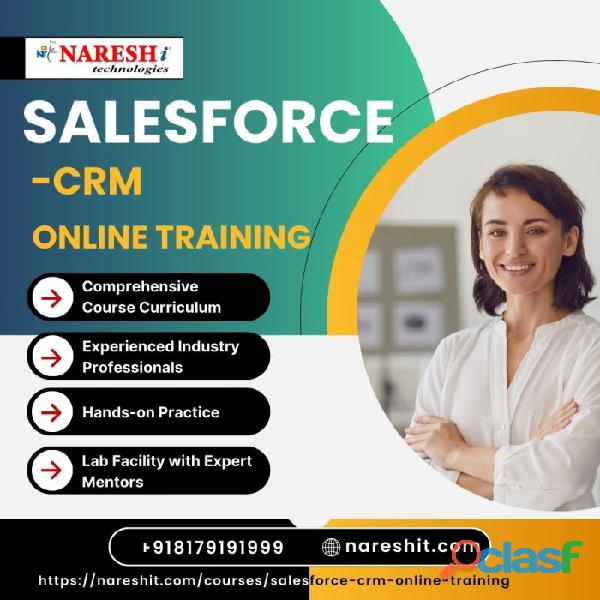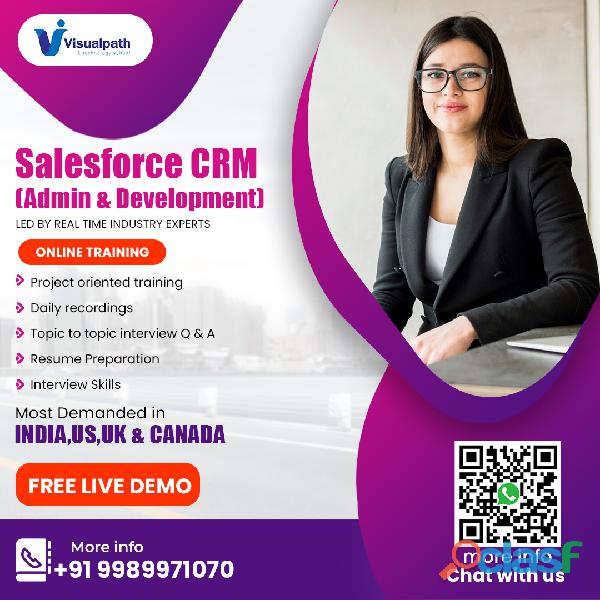SALESFORCE CRM AND DEVELOPMENT IN BANGALORE
• Activate your computer
• Setting Up the User Interface
• Set up the UI & search options
• Organization Administration
• Set your organization's language & locale
• Manage currency Customization
• Create custom profiles & custom fields
• Define dependent picklists
• Customize lookup fields & formula fields
• Customize page layouts
• Customize standard related lists
• Learn about record types & business processes
• Use field-level security Security & Access
• Create & manage your users
• Set organization-wide defaults
• Learn about record access
• Create the role hierarchy
• Learn about the sharing model
• Manually share records
• Set up opportunity team selling & account teams
• Learn about folder access Workflow
• Define workflow
• Set up workflow rules
• Set up workflow tasks & alerts Workflow Approvals
• Plan approvals using workflow
• Use the approval wizard – standard vs. jump-start
• Create workflow approvals
• Data Validation
• Learn about Salesforce CRM data validation
• Create data validation rules
• Learn about custom fields & unique properties Data Utilities
• Import records using the import wizards
• Use mass delete
• Use mass transfer
• Learn about storage utilization
• Analytics
• Create custom reports
• Use advanced filters
• Use conditional highlighting
• Use custom summary formulas
• Create dashboards The AppExchange
• Learn about the AppExchange
• Install an app
• Uninstall an app Marketing Administration
• Use the integrated campaign builder
• Learn about lead queue & lead assignment setup
• Learn Web-to-lead & auto-response rules Service & Support Administration
• Learn about cases & solutions
• Set up case escalation rules
• Identify solution categories & suggested solutions Salesforce Console
• Navigate the Salesforce Console
• Create a Salesforce Console Extending Salesforce CRM
• Learn about custom objects
• Learn about custom tabs
• Learn about custom Web tabs
• Build a custom app
SESSION II:
Designing Applications on Force.com
• Learn about factors to consider when building a data model
• Develop custom objects and fields, encrypted fields, field help, and field history tracking
• Use master detail, lookup, and many-to-many relationships
• Create a user interface for custom applications using the Custom Object tab, Page Layout, and
• Customization options
• Set field attributes on the page layout
• Use the Custom Object queue and event-based workflow rules with field update actions
• Develop custom formulas and validation rules Designing Applications for Multiple Users
• Learn about factors to consider when designing applications for multiple users
• Create profiles, understand what a profile controls (including data access), and customize
• profiles to manage the user experience
• Customize the user experience with record types and page layouts
• Control access to records
• Employ OWD, sharing rules and levels, roles, public groups, and manual share
• Apply profiles, OWDs, role hierarchy, and sharing to restrict access to sensitive data
• Apply OWDs, public groups, and manual sharing to create conditional access to data
• Analyze suitability of FLS, page layouts, and record types to satisfy business requirements Implementing Business Processes
• Use the vlookup, regex, ischanged, isnew, and priorvalue functions to build business processes
• Setting Up the User Interface
• Set up the UI & search options
• Organization Administration
• Set your organization's language & locale
• Manage currency Customization
• Create custom profiles & custom fields
• Define dependent picklists
• Customize lookup fields & formula fields
• Customize page layouts
• Customize standard related lists
• Learn about record types & business processes
• Use field-level security Security & Access
• Create & manage your users
• Set organization-wide defaults
• Learn about record access
• Create the role hierarchy
• Learn about the sharing model
• Manually share records
• Set up opportunity team selling & account teams
• Learn about folder access Workflow
• Define workflow
• Set up workflow rules
• Set up workflow tasks & alerts Workflow Approvals
• Plan approvals using workflow
• Use the approval wizard – standard vs. jump-start
• Create workflow approvals
• Data Validation
• Learn about Salesforce CRM data validation
• Create data validation rules
• Learn about custom fields & unique properties Data Utilities
• Import records using the import wizards
• Use mass delete
• Use mass transfer
• Learn about storage utilization
• Analytics
• Create custom reports
• Use advanced filters
• Use conditional highlighting
• Use custom summary formulas
• Create dashboards The AppExchange
• Learn about the AppExchange
• Install an app
• Uninstall an app Marketing Administration
• Use the integrated campaign builder
• Learn about lead queue & lead assignment setup
• Learn Web-to-lead & auto-response rules Service & Support Administration
• Learn about cases & solutions
• Set up case escalation rules
• Identify solution categories & suggested solutions Salesforce Console
• Navigate the Salesforce Console
• Create a Salesforce Console Extending Salesforce CRM
• Learn about custom objects
• Learn about custom tabs
• Learn about custom Web tabs
• Build a custom app
SESSION II:
Designing Applications on Force.com
• Learn about factors to consider when building a data model
• Develop custom objects and fields, encrypted fields, field help, and field history tracking
• Use master detail, lookup, and many-to-many relationships
• Create a user interface for custom applications using the Custom Object tab, Page Layout, and
• Customization options
• Set field attributes on the page layout
• Use the Custom Object queue and event-based workflow rules with field update actions
• Develop custom formulas and validation rules Designing Applications for Multiple Users
• Learn about factors to consider when designing applications for multiple users
• Create profiles, understand what a profile controls (including data access), and customize
• profiles to manage the user experience
• Customize the user experience with record types and page layouts
• Control access to records
• Employ OWD, sharing rules and levels, roles, public groups, and manual share
• Apply profiles, OWDs, role hierarchy, and sharing to restrict access to sensitive data
• Apply OWDs, public groups, and manual sharing to create conditional access to data
• Analyze suitability of FLS, page layouts, and record types to satisfy business requirements Implementing Business Processes
• Use the vlookup, regex, ischanged, isnew, and priorvalue functions to build business processes
4.00/5
1 reviews



CONTACT




